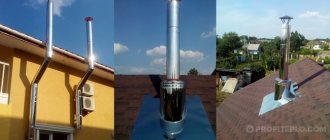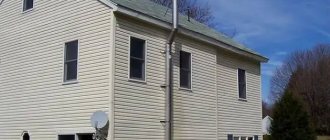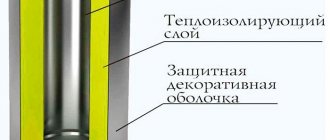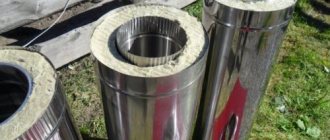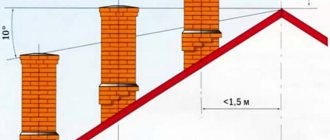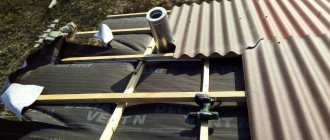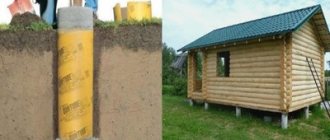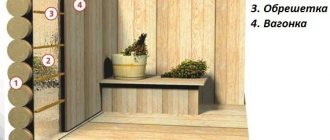The purpose of the chimney consists of three key components: it removes combustion products outside, creates draft in the combustion space and initiates additional thermal convection in the heated room, at least in the first third of its stroke. If the pipe is metal, then when going outside, condensation may form in the body of the pipe. For stainless steel structures this phenomenon is at least unpleasant, but for ferrous metals it is fraught with corrosion, up to the formation of through fistulas. Is there any effective recipe that will avoid the appearance of dew point and the formation of harmful moisture? The sauna sandwich pipe is positioned as a universal miracle cure that allows you to make your chimney balanced and efficient. Is it really true? Let's figure it out.
Design Features
Modern channels for removing smoke from sauna stoves are assembled from pipe sandwich parts. The products are popular among owners of country houses, despite the large selection of materials for creating chimneys.
The sandwich pipe is a double-circuit design. It consists of the following main parts:
- internal chimney;
- layer of thermal insulation material;
- protective decorative shell - an external contour in the form of a pipe product of a larger diameter compared to the internal chimney.
The double-circuit pipe has become widely used by homeowners when installing chimneys. It came to replace single-circuit similar products made of 0.5 mm thick steel. After all, a steel pipe product is not suitable for installing a smoke exhaust duct outside a building. The reason for this is its design, which does not retain heat in the off-season and winter period of the year. In cold weather, condensation forms in a steel channel with one circuit due to a sharp temperature difference. Therefore, the traction effect in the chimney decreases, and even traffic jams appear.
Design features of a thermopipe with two casings Source pechnoy.guru
The internal contour of the pipe sandwich product for removing combustion products is made of stainless steel. Its one-piece design is manufactured using TIG welding. It allows you to make neat, thin seams.
The outer casing is also made by welding from stainless or galvanized steel. The second type of metal allows manufacturers to produce more affordable products. In cooperation with a construction and installation organization, you can also order a chimney made of a sandwich pipe with an outer casing coated with enamel in the required color.
The thermal insulation layer in a product with two circuits is created from a material that is resistant to fire. Manufacturers use high-density mineral wool made from basalt raw materials. Typically the thickness of the thermal layer is 25-100 mm. Design engineers select this parameter taking into account the specifics of installation work and the conditions of use of the chimney.
Chimney with a thermal insulation layer made of basalt mineral wool Source festima.ru
The ends of the sandwich parts for the smoke exhaust duct are made in the form of sockets and narrowed ends. This interface system simplifies the installation process and allows elements to be tightly joined. To increase the strength of joints when installing a chimney, special clamps are additionally used. Depending on the design features of the smoke exhaust channel and the work conditions, parts connected to each other and other elements of the furnace system using flanges can be used.
Crimp type clamp for sandwich chimney Source ytimg.com
We make a chimney structure for a bathhouse ourselves
We already know that the chimney consists of 1 meter long segments inserted into one another. You should make the internal element of a sandwich pipe for a bathhouse with your own hands only using stainless steel (this condition must be met). The external one can be made of any material, for example, brass or copper.
The outer chimney pipe can be made of galvanized steel
You should not use only galvanized pipes: when heated, their diameter changes. Internal insulation should be made of mineral wool, basalt fiber or expanded clay. When laying it, keep in mind one nuance: you must fill it manually, ensuring a ten-centimeter overlap.
How to connect pipe segments. There are several connection methods: bayonet, “cold bridge”, flange, etc.
Note! For a bath, the choice is limited to two methods - “by condensate” or “by smoke”.
They differ in that:
- in the first option, the inner pipe of the sandwich mounted on top fits into the socket of the lower pipe, so moisture does not get on the insulation. But in this case, smoke may leak out;
- the “smoke” connection is characterized by the absence of the above disadvantage. At the same time, condensation flowing down the walls can penetrate into the sandwich through the cracks and damage the insulation;
- Most construction organizations leave the right of choice to the customer. For premises, including baths, it is recommended to install a sandwich pipe with a “smoke” connection. This is due to the fact that in products of this type condensate is formed in small quantities. The main requirement remains the same: when installing the chimney, ensure the tightness of the joints.
Preparatory work. First of all, the location of the chimney axis is checked. Owners who understand this issue carry out this activity even at the stage of constructing the foundation of the furnace. The distance from the sandwich to the wall should be no more than 25 centimeters. In addition, the chimney pipe should be routed so that it does not cross the beams and rafters of the roof and attic. This work can be carried out after arranging the subfloor and securing the wooden elements of the roof.
The pipe must pass between the wooden roof slabs without touching them
After installing the stove on the subfloor, set it in a vertical plane to its normal position. In this case, it is necessary to take into account the thickness of the floor covering and the height of the floor “pie”. Lower the plumb line into the center of the stove outlet flange and see the results: this accessory should not intersect the load-bearing elements of the roof. Only then will the final installation of sandwich pipes in the bathhouse be carried out without any particular difficulties.
Installation procedure. The main work is performed in the following order:
- in the place where the pipe passes through the ceiling, a so-called ceiling-pass assembly (hereinafter referred to as PPU) is mounted;
- The first pipe element is installed on the outlet flange of the furnace. It must be single-walled. The sandwich pipe is installed from the second level;
- Double-wall pipes and, if provided for by the chimney design, elbows and tees are installed one by one. They are brought out through the ceiling, after which they are attached to the walls and to each other;
- the place where the pipe passes into the attic is insulated;
- A revision with a stand is mounted up to the attic. It will provide the opportunity to clean the chimney from soot and, in general, to inspect its cavity for preventive purposes;
- continuation of the installation of the chimney in the attic with subsequent removal of the pipe to the outside.
- where the pipe exits through the roof, thermal insulation is performed;
- if the pipe rises high above the roof, this part is secured with guy wires
- A spark arrester and fungus are installed on top of the finished product.
Good to know! Only sandwich products can be installed in the attic; installation of additional elements is prohibited.
Advantages of chimneys made from sandwich channels
Metal pipelines have been used for decades to remove smoke from furnace devices. This is explained by their optimal cross-section for the passage of combustion products. They have a smooth surface inside that does not interfere with the removal of gases. There is less soot accumulation on their smooth walls. In addition, installation work is carried out using large parts. Therefore, installing a sandwich chimney is simpler and faster compared to laying a brick channel.
The use of double-circuit products for smoke removal also has the following advantages:
- the outer surface of the pipes heats up less due to the presence of a heat-insulating layer between the two circuits;
- the operating temperature of the exhaust gases can reach 850 degrees;
- the level of fire safety of the building increases;
- There is no noise when removing smoke.
The use of stainless steel in the manufacture of sandwich pipes increases the resistance of chimneys to corrosion. After all, its occurrence is well facilitated by the exhausted aggressive gases.
Chimney sandwich parts made of stainless steel have high corrosion resistance Source roof-tops.ru
Compared to conventional metal chimneys, channels made of sandwich pipes have improved technical characteristics and provide a higher level of fire safety. Thanks to the design, it was possible to achieve minimal condensation formation when removing smoke through dual-circuit products.
The sandwich chimney is characterized by stable draft due to a more even internal temperature along the entire length of the channel. In addition, the external circuit does not heat up much. Therefore, upon contact, a person will not receive a burn, with the exception of contact with the initial section of the chimney near the heating device. Indeed, at this point, even the outer thermally insulated wall of the structure becomes very hot. Therefore, it is dangerous for humans and can even cause a fire in the bathhouse.
The lower, very hot section of the sandwich chimney near the stove Source topijar.ru
Another advantage is the service life of the chimney sandwich pipe. Its durability is 15-20 years if installation technology is followed.
Output through the ceiling
Installation of a chimney in a bathhouse through the ceiling is carried out as follows.
For the exit, a special unit is installed in the ceiling covering, which creates reliable fastening and high fire safety: Despite the fact that such a pipe is a two-layer structure with non-flammable thermal insulation in the middle, to increase the level of safety, a hole is made in the ceiling opening for the chimney installation of a small pipe, which is 15-20 cm in diameter larger than the diameter of the chimney.
From the bottom, such a hole is sealed with a steel sheet. The part that ends up in the attic is filled with non-combustible material. To do this you can take:
- basalt wool;
- sand;
- expanded clay
A large-volume rolled pipe range for insulating a sandwich chimney can be replaced with a box made of non-combustible materials:
A sandwich - a smoke exhaust - is passed into the box, and the empty space is also filled with non-flammable material:
The video provided details how such work is carried out.
Characteristics of sandwich pipe
Sandwich chimneys are made with the same appearance. The production of these products brings good income. Therefore, unscrupulous manufacturers have appeared that produce low-quality products. They don't care about reputation. Their goal is to obtain maximum profit. Therefore, to create a durable and efficient chimney, you need to seek help from a specialized construction and installation company with an unblemished reputation that cooperates with reliable sandwich pipe manufacturers.
Metal fabrication
Professionals pay special attention to the quality of the metal of sandwich pipes, especially from which the inner casing is made. Because products made from low-grade steel are deformed when exposed to high temperatures and even burn out. Such defects also occur during operation if the metal does not meet the operating characteristics of the furnace.
Burnt-out inner casing of a low-quality sandwich chimney Source ad-cd.net
Responsible manufacturers label their products and supply them with technical data sheets. They indicate the grade of steel.
The universal metal is AISI 316i stainless steel. This steel has ductility, high resistance to corrosion and can withstand temperatures up to 850 degrees. For bathhouse stoves, chimneys made of alloyed stainless steel AISI 316 and durable alloy AISI 439 with titanium additives are also suitable.
See also: Catalog of companies that specialize in engineering systems and related work
Inner diameter
An important technical parameter is also the diameter of the internal contour. It is selected by engineers taking into account the thermal power of the furnace device. The most commonly used sizes of sandwich chimney pipes are:
- 158 mm – up to 3500 W;
- 189 mm – 3500-5200 W;
- 220 mm – 5200-7000 W.
The indicated diameters are the minimum permissible values. However, the cross-section along the entire length of the smoke channel must be no less than the size of the stove outlet pipe.
Inner diameter of the smoke exhaust sandwich duct Source ytimg.com
Thermal insulation
Significant characteristics also include the type and thickness of the thermal insulation layer. High-quality chimneys with a sandwich structure are made using mineral wool. It does not burn and has a significant coefficient of thermal resistance.
The thickness of the heat insulator is affected by the type of heating equipment and smoke temperature. Wood-burning stoves typically discharge combustion products heated to a maximum of 600 degrees. For such operating conditions, a chimney is assembled from sandwich pipes with a thermal insulation layer 50-100 mm thick.
How to choose a pipe
When purchasing such products, pay attention, first of all, to the following points:
- strength of steel. It is its quality that determines the reliability of the design and the service life of the final product;
- pipe filling material and its tightness to the surface;
- strength of the joint. Two pipe elements are connected by welding. Therefore, the connection must be reliable, durable, without defects;
The key point is this: when choosing, preference should be given to sandwich pipes for a bath with a diameter of 15-20 centimeters.
It should be noted that the best option to purchase is a product made by laser welding, since it is characterized by high quality. And, of course, study the inside of the sandwich pipe. The advantages of stainless and galvanized surfaces were briefly discussed above. It should be added to the above that it is recommended to use a galvanized product for gas boilers, since it tolerates contact well with the combustion products released during the operation of such units. If you have chosen sandwich pipes for a stainless steel bath, you can find out approximate prices for these products from the table below.
Table 1
| Scope of application of the chimney | Length, meters | Diameter internal/external, millimeters | Cost (rubles) |
| Furnaces | 1 | 115×200 | 2300 |
| Boilers, fireplaces, stoves (matte stainless steel, enameled) | 1 | 115×200 | 2300 |
| Furnaces | 1 | 115×200 | 1400 |
| Furnaces | 0,5 | 115×200 | 975 |
Chimney outlet options
The design features of the bathhouse affect the installation of sandwich pipes. It can be performed inside or outside the building. When laying internally, holes are created in the ceiling and roof. During external installation, the chimney is fixed to the wall with a preliminary hole created in the supporting structure for laying the pipe.
Basic options for installing a sandwich duct for smoke Source feflues.ru
Internal installation
It is the installation of a chimney from sandwich pipes through the roof with the preliminary creation of a passage in the attic floor that makes it possible to reduce the negative external influences on the smoke exhaust system. With this installation method, the appearance of condensation in the channel is practically eliminated.
This option is often used in a bathhouse because it does not complicate the installation of a water tank. After all, its installation is carried out above the stove. It is mounted at the initial section of the smoke exhaust system. Often, a mesh section is installed in the same section, allowing stones to be placed for better heating and creating steam in the room.
Mesh sauna heater Source oteplicax.ru
A module without thermal insulation is always installed between the furnace and the sandwich pipe. The section is usually equipped with a gate. It is a damper to change the amount of heat removed along with the smoke.
Installation inside an object is a labor-intensive process, since you have to create at least two holes. This option is not suitable if you need to save the free internal space of the bathhouse.
External installation
When a chimney is laid through a wall, labor costs are reduced. After all, you need to create one penetration in the supporting structure. The parts are attached to the outer surface of the wall using special brackets.
Less labor-intensive installation of a chimney from sandwich pipes through the wall helps to save free internal space. This option reduces the likelihood of fire and minimizes the risk of poisoning from combustion products.
The disadvantage of such a gasket is the negative impact of the external environment on the channel. It creates more condensation. Some people are still not satisfied with the placement of a metal pipe on the wall.
Installation of a channel for a sauna stove
If the chimney is routed through heating equipment, it can be connected directly to the system or heat exchanger. The vertical channel is discharged through the wall or ceiling.
To obtain the maximum effect from fuel combustion, an ordinary metal cylindrical product is removed from the furnace. The sandwich pipe itself is mounted on top of it.
As a result, the maximum temperature is maintained due to the powerful thermal radiation emanating from the pipe. The heating temperature is almost the same as in the firebox. To soften the radiation without losing heat, a mesh filled with stones is placed on the chimney. The heated cobblestones will dry the steam room after the stove goes out.
In some cases, the chimney can be used as a water heater. To do this, instead of a metal product leaving the furnace, a heat exchanger is installed.
Chimney equipment
The installation company completes the chimney in accordance with the approved installation diagram. It is not difficult for a specialist to select the necessary parts. After all, manufacturers produce a full set of required sandwich elements. They allow for quick and high-quality installation of a sandwich chimney.
When installing a smoke exhaust system from a stove in a bathhouse, the following is usually used:
- a transition piece that allows you to connect the chimney with the outlet of the furnace equipment;
- a right-angle bend designed to change the direction of the channel;
- tee with a central pipe at an angle of 87 degrees - used to transition from a horizontal section to a vertical pipe;
- a part with a hermetically sealed hole for cleaning the channel;
- a support platform equipped with a tap designed to drain accumulated moisture - used together with an inspection element;
- a wall bracket that allows you to attach the chimney to the wall;
Fastening structure for fixing smoke ducts to the wall together with an inspection element and a support platform Source katlavan.ru
- a tee with a central pipe located at 45 degrees - used when installing a single chimney for two stoves;
- a metal plug for closing unprotected heat-insulating material when connecting a single-circuit pipe with a thermoelement - prevents the penetration of a humid environment into the heat insulator;
- 45 degree bend - used to bypass protruding structural elements of a building, for example, a roof canopy;
- clamp for strengthening the connections of sandwich parts;
- straight pipe elements 1000 mm or 500 mm long;
- a conical roof with different angles depending on the slope of the roof slope - used when laying a chimney through roofing material and used in conjunction with a metal apron;
Cone roof Source ytimg.com
Okapnik Source prom.st
- a cone-shaped part with which the thermal chimney ends - usually installed with a spark arrester and a fungus in the usual design or a similar thermoelement, deflector, weather vane.
Nuances requiring special attention
Of course, the manufacturer of the product is of great importance. However, a lot of fakes have appeared on the market. It is difficult for the average person to grasp all the subtleties, therefore, in order not to make mistakes, it is worth listening to the advice of professionals:
- Before going to the store, take a small magnet, wrap it in a thin cloth and put it in your pocket.
- If the manager tells you that the pipe is made of high-quality stainless steel, just attach a magnet to it. Even the slightest attraction indicates that you are being deceived. The fabric prevents possible scratches.
- Be sure to make sure that the chimney is free of deformation, chips and dents.
- Pay attention to the thickness of the metal of the cylindrical product, which should be more than 0.5 mm. The durability of the entire structure depends on this parameter. The larger it is, the longer the service life will be.
- Each part must have an absolutely even shape. It is important that there are no traces of interruption in the welds.
- It is advisable to try to assemble several design parts directly in the store. All connections should be strong and without gaps. No consolidated movement of elements is allowed.
- Of course, everyone wants to save money, but this should not be done. It must be remembered that quality plays a major role, and price fades into the background.
Basic rules for installing a sandwich chimney
The number of all components depends on the length of the chimney. Regardless of the configuration, it is not created with a length of less than 5 m. If the chimney is installed through the wall directly in the steam room or its installation is carried out elsewhere in the bathhouse, conditionally parallel to the floor, then the length of the straight “horizontal” section should not be more than 1000 mm. In this case, such a segment is fixed with an inclination of 3 degrees towards the condensate collector. This allows moisture to flow in the opposite direction from the heating equipment.
When installation is carried out next to a wall, the channel is fastened at a distance from the supporting structure of the building, which is determined by the manufacturer of double-circuit pipes. However, the minimum distance is 250mm. To simplify the installation process, adjustable brackets are often used. They are fixed at a distance of no more than 2000 mm from each other.
During installation, the distance from the chimney to the wall must be at least 250 mm Source krovlyakryshi.ru
If the sandwich pipe is located at a distance of 1500 mm from the ridge, it must rise above it by no less than 500 mm. When the distance is 1500-3000 mm, the head of the chimney should be flush with the ridge. If the thermal pipe is mounted at a greater distance, then the height of its upper cut is determined by drawing a conditional line from the ridge at an angle of 10 degrees relative to the horizon.
The height of the chimney above the roof Source stroyfora.ru
If there is a flat roof, the thermal pipe must rise above it by at least 500 mm. When the roof is covered with a fire hazardous material, the height of the sandwich chimney above it must be at least 1200 mm. Typically, a structure of this or greater length is secured with braces.
Important! The smoke exhaust channel is installed with a minimum number of bends. Its effective operation will be ensured if the pipe changes direction no more than 3 times.
How to pass through a roof
As a rule, the roof of a bathhouse is made of flammable materials, so it is important to ensure the proper level of fire safety in the area where the chimney passes. The sequence of actions can be described as follows:
- The roof surface is marked and cut in such a way that the distance from the outer layer of the sandwich to the edge of the opening is at least 13-15 cm.
- An under-roof metal plate of the appropriate size with an oval-shaped hole is placed on the next sandwich, after which the pipe is joined to the already installed chimney. The sheet is attached to the inner surface of the roof using self-tapping screws of the appropriate length.
- Another element is mounted on top of the pipe - a corner roof trim. This module, as a rule, is made of soft lead, which makes it possible to press it as tightly as possible to the roof and the pipe itself.
- The space between two metal sheets is filled with heat-resistant basalt or mineral wool, and for reliable protection from precipitation, the external cracks are treated with bitumen roofing sealant.
Stages of installing a chimney from thermal pipes
After concluding the contract, developing the project and its approval by the customer, the construction company will install a chimney in the wall or roof in stages:
- An adapter is put on the stove pipe. It is lubricated with a sealant that can withstand temperatures of at least 1000 degrees. For reliability, the transition element is secured with a metal clamp.
- A length of single-wall pipe is installed to prevent the sandwich from overheating, which turns to stone when exposed to high temperatures. This leads to failure of the chimney.
- A heater or metal container for heating water is mounted on a single-wall pipe piece.
Metal tank for heating water in a bathhouse above the stove Source pechimax.ru
- If a chimney is installed through a wall in a wooden house, bathhouse or other building, a chimney section no more than 1000 mm long is created with a 3-degree slope towards the street.
- A hole is prepared in the wall for the chimney outlet. Its diameter is always larger than the cross-section of the sandwich pipe. If the wall is made of combustible material, then the gap between the smoke exhaust duct and the supporting structure is at least 200 mm. Often a square hole measuring 400*400 mm is created.
- The walls of the opening are covered with basalt cardboard.
- A factory-made chimney passage through the wall is installed.
Pass-through block in the form of a box Source masterweld.ru
Little things that need to be taken into account when installing a pipe in a bathhouse
- It is better to make the section of the chimney directly adjacent to the stove from an ordinary monopipe (preferably stainless steel), and make the transition to a sandwich 20-30 cm before passing through the ceiling or wall. This “bare” section of pipe serves as an additional “heater” for the room. This is much more efficient and healthier than releasing heat into a chimney. Some even set up a kind of heater here: they fix a net around it, into which small stones are poured. In this case, almost all of the hard infrared radiation from the pipe is absorbed, and after the procedure is completed, the stones continue to give off heat for a long time, drying the room well. The result is a double benefit: the pipe does not burn out, giving off heat to the stones, and the steam room dries well, preventing fungi and mold from developing.
- When designing a chimney, please note that the maximum length of the horizontal section of the chimney (if any) should not exceed 1 meter.
- The chimney should not touch any communications, especially gas pipes or electrical wiring.
- Do not forget to provide for the possibility of cleaning soot - it is necessary to install inspection hatches.
- It is necessary to calculate the chimney so that there are no connections in the passage units.
- If the pipe passes through the attic, it is better to additionally insulate it. Even if it's a sandwich. If this is not done, condensation will form during the cold season. The hot pipe will warm up all the air in the attic. So condensation will flow through the vapor barrier, or through the roofing material. Therefore, we bring the sandwich to the exit from the roof, install a passage unit, and only above it install a mono-pipe.
- If the roof of the bathhouse is pitched, then the upper edge of the chimney should protrude 50 cm above the ridge. If the roof is flat, then it should “rise” by 1 meter. To ensure rigidity, it is better to secure the outer pipe with braces.
- If the roofing material is flammable, you need to install a spark arrestor on the pipe.
Compliance with fire safety
Even with good thermal insulation, strong heating of the outer surface of the chimney cannot be avoided. Temperatures of 300 degrees can easily ignite dry wood. Therefore, the process of constructing a structure made of sandwich pipes requires strict adherence to fire safety regulations:
- Do not install the device near flammable materials.
- Such a system should be located at a distance of 25 cm from any flammable surface. If the heating temperature is lower, this gap can be reduced, but it is important that it remains within 10 cm.
- Air is considered the best thermal insulation. There is no need to fill the box through which the smoke channel passes with expanded clay or fill it with mineral wool.
- When installing such a structure on the roof, in addition to heating the pipe, it is necessary to take into account the direction of the flow of hot air and flying sparks.
- The elevation of the cylindrical product above the ridge, if the roof is made of fire hazardous material, must be more than 1 m.
Operation of chimney sandwich systems
After installing the chimney, you should conduct a test fire to check the tightness of the joints and make sure that the adjacent structures and materials do not heat up.
When using the system for the first time, light smoke and a specific smell may appear from the heating of oil residues, sealant, and dust on the surface of the pipes.
Proper operation involves timely removal of soot. When cleaning, do not use any detergents. A review of the best cleaning products and methods is discussed in our other article.
It is better if it is carried out by an organization that has a special license giving the right to carry out this type of work.
Final installation
Once assembly is complete, the protective film must be removed. The size of a sandwich chimney must be approximately 5-6 m, starting from the head and ending with the grate. Seams and existing gaps are sealed with a sealant, preferably heat-resistant, withstanding temperatures of 1000 °C. The composition is applied using the following technology:
- In internal and external pipes the outer part is coated.
- When there is a transition from a single-walled structure to a double-walled one, the entire outer surface is sealed.
- A single-walled cylindrical product and the corresponding module are connected in the same way as the previous version.
After sealing, it is necessary to carefully check the most fire hazardous areas where heating will be at its maximum temperature.
To ensure easy maintenance of the chimney, an inspection is installed. It can be removable or equipped with an opening door.
